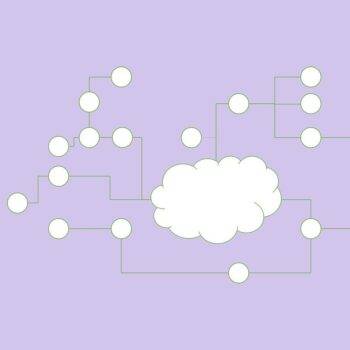
Between utopia and reality: the dynamic cloud. The dynamic distribution of workloads between various cloud platforms is the logical consequence in order to be able to fully utilize the advantages of the technology. Unfortunately, this is still a long way off. Gaia-X, on the other hand, sends the first positive signals in this direction.
There is a wide range of products, functionalities and price scales for various cloud platforms. Companies can choose from the offers of hyperscalers as well as numerous medium-sized providers who have specific cloud portfolios including bare metal and dedicated compute. As a rule, organizations use more or less flexible hybrid cloud infrastructures by connecting the public clouds of hyperscalers to their own infrastructure.
Flexible hybrid cloud
Within a hybrid cloud, customers want a high degree of flexibility, including the ability to easily transfer individual components of the cloud infrastructure to other providers. A dynamic cloud is basically a multi-cloud environment in which workloads and data can be moved between the individual clouds. This can enable the most effective mix and scaling in each case by identifying and using free instances in an environment of multi-cloud providers.
This would allow customers to take advantage of the cloud in the best possible way. In addition, it could promote competition between providers in the market and increase innovation. In practice, however, such a cloud environment is still a long way off, because although the offers are similar, the underlying technologies are very different.
No two clouds are the same
If all cloud environments were at least to a certain degree compatible with one another, it would be easy to develop a corresponding abstraction layer with which different clouds can be dynamically combined under one surface. Indeed, there are already cloud orchestration tools that, in theory at least, have the potential to make this possible. They offer a single user interface that can be used to measure the performance of individual clouds, compare prices and move workloads based on requirements. On paper, these give great hope for future dynamic cloud infrastructures, but they are not yet practical at the moment.

Marcus Busch, Leaseweb
Because although all cloud providers, especially the hyperscalers, basically deliver the same product, they differ in many details, especially in the interfaces and above all in the APIs. As a result, even simple migrations between clouds can only be carried out with great effort. And as the various providers continuously develop their cloud services, creating, updating and managing potential cloud orchestration tools becomes correspondingly complex - and almost impossible in practice.
Virtualization platforms in the cloud: a bogus solution
To support their users in migrating between cloud environments, hyperscalers have been offering their virtualization platforms to operate in the cloud for some time. The operation of VMware in the Amazon cloud has been heavily advertised in recent months. But this concept takes the actual intention of the cloud ad absurdum. Because although the migration problem for some of the workloads can be solved in this way, the companies pay very high public cloud prices in return for using their environment virtualized in the cloud. For something they could achieve at a fraction of the cost on bare metal infrastructure, for example.
The problem of the lack of compatibility of the hyperscalers is of a fundamental nature. For cloud providers there are hardly any advantages to making their clouds compatible with other offers. In addition to the proprietary formats, this can also be recognized very easily by the fact that the prices for uplink and downlink differ suspiciously. Sending data to the cloud is cheap - but getting it out of the cloud is disproportionately expensive. Seldom has the attempt to establish a manufacturer link been more obvious. And it is unlikely that the currently leading hyperscalers will change this strategy in the near future and ensure more compatibility - and thus dynamism - on their own.
Gaia-X brings the dynamic cloud within reach
Gaia-X shows that it can be done differently by standardizing the European initiative cloud offerings and creating a counterweight to the American providers of cloud solutions. This partnership of European industrial partners aims to offer data mobility via an open, federated and secure cloud setup. The implementation of not only uniform APIs, but also clear service descriptions and functionalities would definitely contribute to making the infrastructure actually mobile and thus dynamic.
The dynamic hybrid cloud has future opportunities
We can see that the cloud is not yet as “dynamic” as we would like. However, Gaia-X offers a promising perspective for the future. That doesn't mean, however, that companies can't manage their hybrid clouds very dynamically today. The combination of offers from hyperscalers and smaller providers already promises a high level of flexibility. For example, customers can choose from potentially hundreds of different models and specifications from the broad portfolios of medium-sized cloud providers, which can be precisely tailored for the optimal performance of a workload. This can help create an efficient cloud mix that places each workload in the right cloud for it.
Until the time comes that cloud orchestration solutions or approaches such as Gaia-X provide more dynamic management options, companies must carefully think about how they combine the cloud services they need and how they set up their infrastructure accordingly in order to ensure vendor lock-in and high levels of vendor lock-in Avoid costs.
More on this at Leasweb.com
About Leaseweb Leaseweb is a leading provider of IT infrastructure services (Infrastructure as a Service; IaaS) with 18.000 small to very large customers worldwide. Services include public cloud, private cloud, dedicated servers, colocation, content delivery network and cybersecurity services backed by exceptional customer service and technical support. With more than 80.000 servers, Leaseweb has been providing infrastructure for business-critical websites, network applications, e-mail servers, security and storage services since 1997. The company operates 20 data centers at locations in Europe, Asia, Australia and North America, all of which are supported by a state-of-the-art worldwide network with a total capacity of more than 10 TBit / s.
